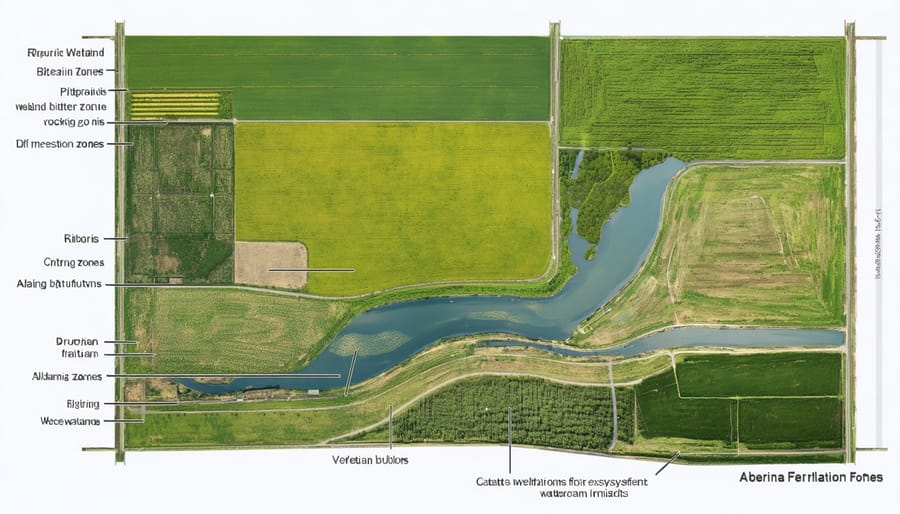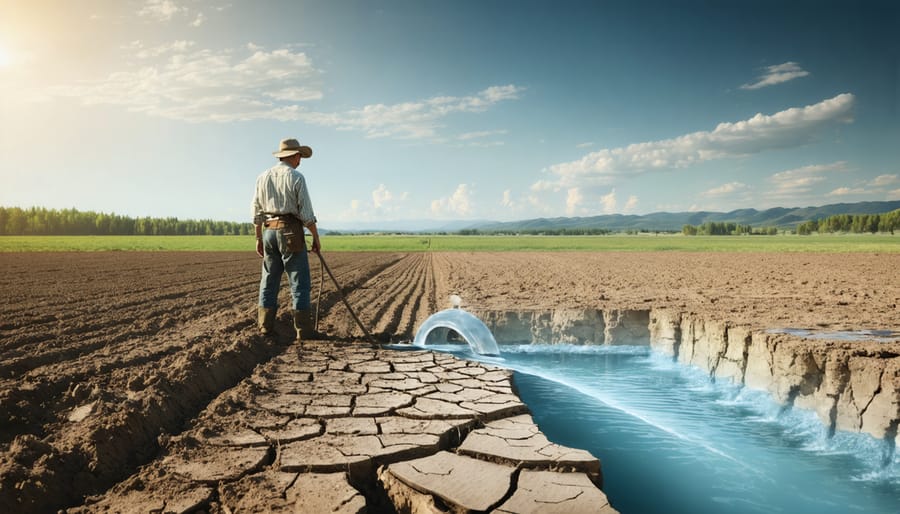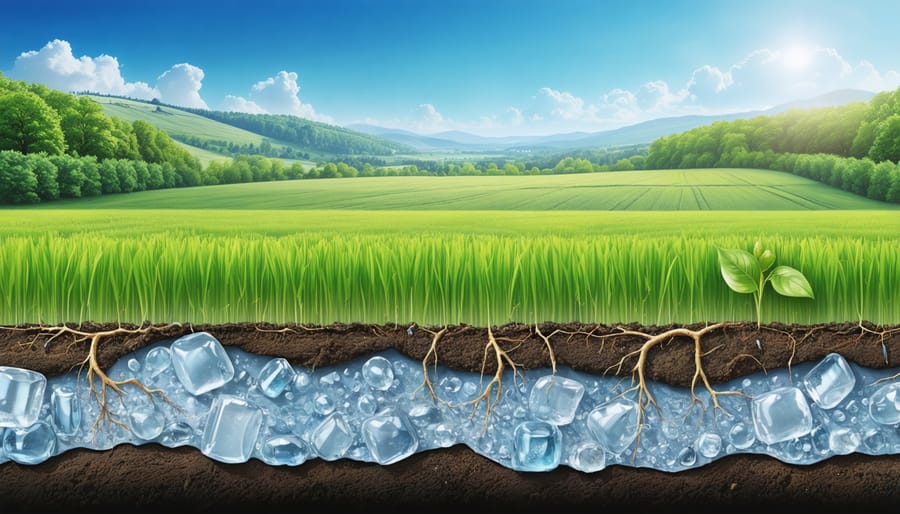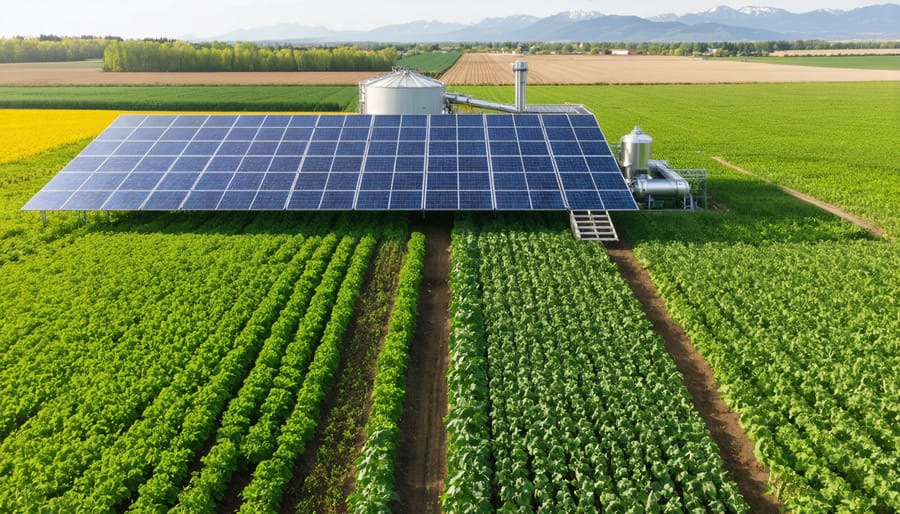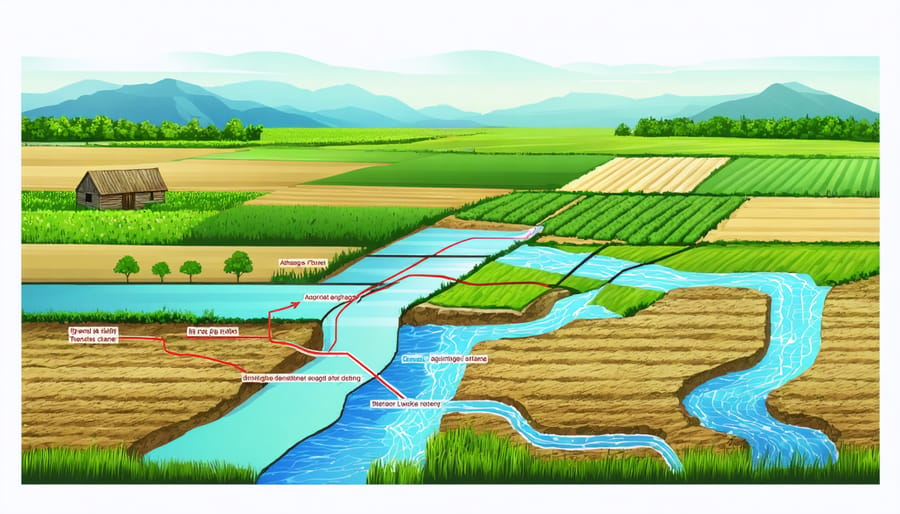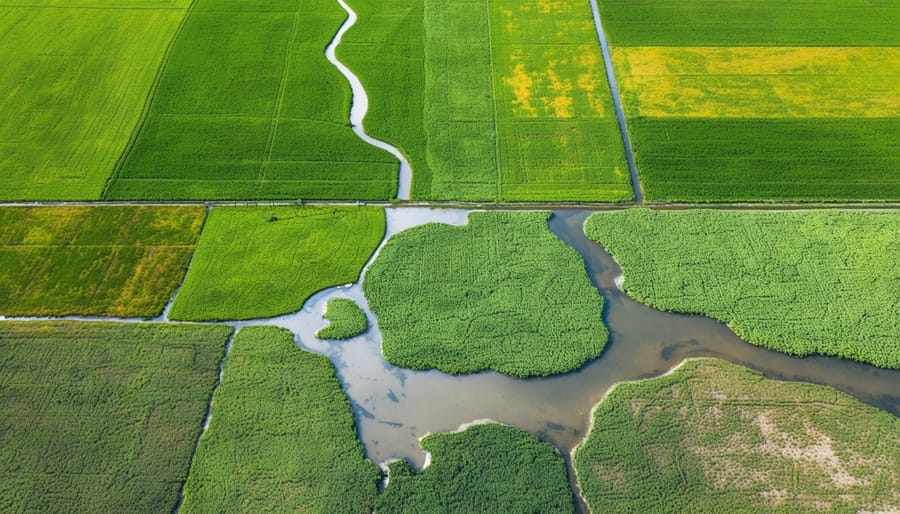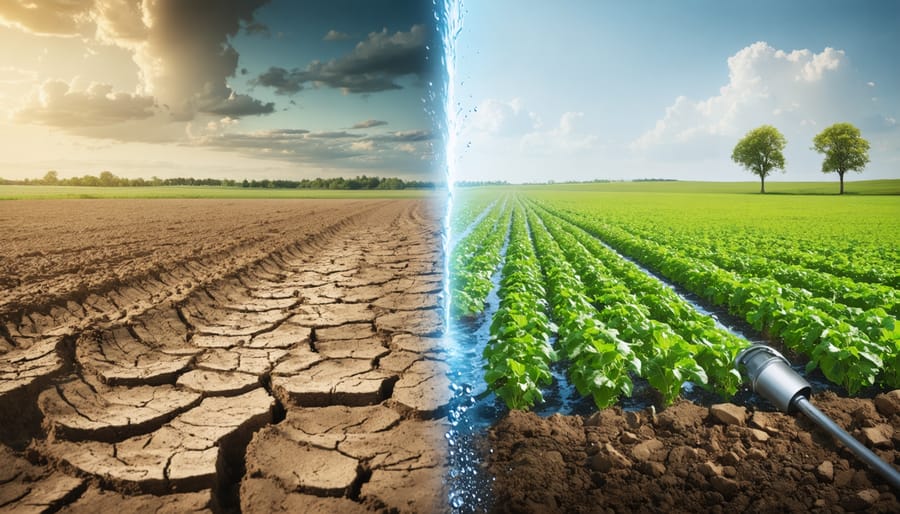Implement riparian buffer zones along waterways to filter agricultural runoff, reducing sediment and nutrient pollution by up to 85%. Install precision irrigation systems that minimize excess water usage while maintaining optimal crop yields across Alberta’s diverse growing regions. Adopt integrated pest management strategies to decrease chemical pesticide applications, protecting both surface and groundwater quality. These proven methods of preventing water pollution have helped Canadian farmers maintain productive operations while safeguarding our vital water resources.
Recent data from Agriculture and Agri-Food Canada shows that farms implementing these practices have reduced their water pollution footprint by 40% while maintaining or improving crop yields. Through collaborative efforts between agricultural communities and water conservation experts, these solutions offer practical, cost-effective approaches to protecting our watersheds for future generations.
[Word count: 107]
On-Farm Water Treatment Solutions
Natural Filtration Systems
Harnessing nature’s own cleaning power through natural filtration methods offers Alberta farmers an effective and sustainable approach to water pollution management. Constructed wetlands, in particular, have shown remarkable success in filtering agricultural runoff across the Prairie provinces.
Take the example of Sarah Thompson’s farm near Red Deer, where a strategically designed two-hectare wetland system effectively removes up to 90% of excess nutrients from field runoff before it reaches the local watershed. The system combines cattails, bulrushes, and native water plants that naturally filter pollutants while creating valuable wildlife habitat.
Biological filtration using microorganisms and plants can be implemented at various scales. Many Alberta farmers have successfully integrated vegetated buffer strips along waterways, which trap sediments and absorb excess nutrients. These living filters require minimal maintenance while providing additional benefits like erosion control and increased biodiversity.
Local agriculture expert Jim Morrison notes, “We’re seeing more farmers embrace these systems because they’re cost-effective and work with nature rather than against it. A well-designed wetland can serve your farm for decades with minimal intervention.”
To get started, consider mapping water flow patterns on your property and identifying natural low points where wetland construction would be most effective. The Alberta Wetland Policy provides guidelines and potential funding support for implementing these systems, making them an accessible option for farms of all sizes.
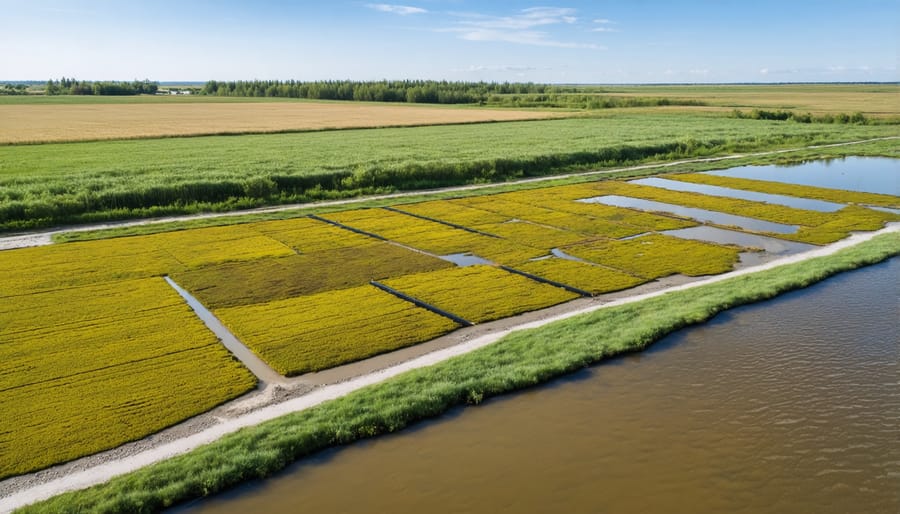
Advanced Treatment Technologies
Modern water treatment technologies have revolutionized how we handle agricultural runoff and protect our water resources. Here in Alberta, farmers are increasingly adopting advanced filtration systems that combine traditional methods with cutting-edge innovations.
Membrane bioreactors (MBRs) are gaining popularity among larger operations, offering exceptional water purification through a combination of biological treatment and membrane filtration. These systems can remove up to 99.9% of contaminants, making treated water suitable for irrigation or safe release into local waterways.
UV disinfection systems are another breakthrough technology that’s proving cost-effective for farms of all sizes. Unlike chemical treatments, UV systems leave no residual compounds and effectively eliminate harmful pathogens without affecting water quality. Many Alberta farmers report significant success using UV systems in combination with basic filtration methods.
Constructed wetlands enhanced with smart monitoring systems represent a blend of natural and technological solutions. These systems use native plants and engineered substrates, coupled with sensors that track water quality in real-time. The Lethbridge Research Centre has documented several successful implementations, showing how these systems can handle seasonal variations in runoff volume.
For smaller operations, modular treatment units offer a scalable solution. These compact systems can be expanded as needed and typically include multiple treatment stages: sediment removal, biological treatment, and final polishing. They’re particularly effective for dairy operations and intensive livestock facilities, where water quality requirements are stringent.
Remember to consult with local agricultural extension services for guidance on selecting the most appropriate technology for your specific needs and conditions.
Precision Agriculture Techniques
Smart Irrigation Systems
Modern smart irrigation technologies have revolutionized how Alberta farmers manage water resources while minimizing pollution risks. These systems combine soil moisture sensors, weather monitoring stations, and automated controls to deliver precise amounts of water exactly when and where crops need it.
Here in Alberta, many farmers have found success with soil moisture probes that track water levels at different depths. These probes communicate with central control systems to prevent over-irrigation, which can lead to runoff and groundwater contamination. For example, the Henderson family farm in Lethbridge reduced their water usage by 30% while maintaining crop yields by implementing these precision systems.
Variable-rate irrigation technology allows farmers to create customized irrigation maps based on soil type, crop requirements, and field topography. This targeted approach not only conserves water but also minimizes the movement of agricultural chemicals into nearby water sources. The technology can adjust water application rates in real-time, ensuring optimal soil moisture levels across entire fields.
Many irrigation districts across Alberta now offer cost-sharing programs for farmers looking to upgrade their systems. Local agricultural extension services provide training and support for implementing these water-smart solutions. When combined with proper maintenance and regular system audits, smart irrigation systems can significantly reduce water waste while protecting our valuable water resources.
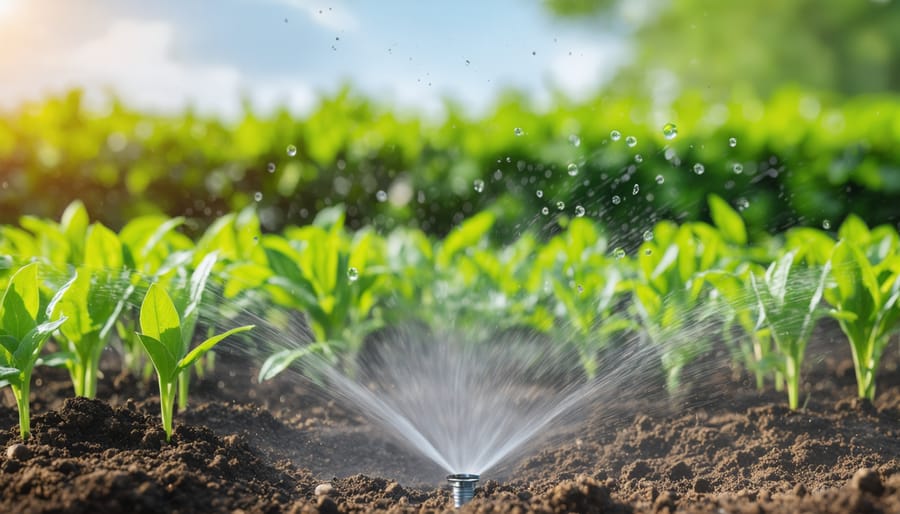
Nutrient Management
Effective nutrient management is crucial for protecting our waterways while maintaining crop yields. Here in Alberta, we’ve seen tremendous success with precision farming techniques that help farmers apply just the right amount of fertilizer at the right time. For example, soil testing before application can reduce excess nutrient runoff by up to 30% while saving on input costs.
Working with local agronomists, many Alberta farmers have adopted the 4R Nutrient Stewardship principles: right source, right rate, right time, and right place. This systematic approach has proven particularly effective in reducing phosphorus and nitrogen losses into water systems.
Consider splitting fertilizer applications throughout the growing season rather than applying all at once. This practice, known as split application, helps plants utilize nutrients more efficiently and decreases the risk of runoff during heavy rains. Many producers in the Red Deer region have reported both environmental and economic benefits from this approach.
Variable rate technology (VRT) is another game-changer for nutrient management. Using GPS and soil mapping, VRT allows for precise fertilizer application based on specific field conditions. Local farmer Jim Peterson from Lacombe County shared that implementing VRT helped reduce his fertilizer use by 15% while maintaining yield targets.
Remember to maintain buffer zones between fertilized areas and water bodies. These natural filters can capture excess nutrients before they reach our streams and rivers. The recommended minimum width is 10 metres, though wider buffers provide better protection in areas with steeper slopes.
Water Reuse Strategies
Greywater Systems
For Alberta farmers looking to reduce water pollution while conserving valuable resources, implementing greywater systems offers a practical and cost-effective solution. Greywater systems collect and treat water from sinks, showers, and laundry facilities, making it suitable for irrigation and other non-potable uses on the farm.
Many Alberta farmers have found success by starting with simple greywater collection from their farm buildings. For example, the Peterson family farm near Red Deer installed a basic system that diverts washing machine water to their greenhouse, saving approximately 30,000 litres of water annually while reducing the strain on their septic system.
When designing your greywater system, consider incorporating natural filtration methods like reed beds or constructed wetlands. These biological filtering systems not only clean the water but also create valuable wildlife habitat. Local farmer Sarah Matthews shares, “Our reed bed system handles about 200 litres daily and has attracted native birds we never used to see on the property.”
To maximize benefits, connect your greywater system to specific agricultural applications:
– Greenhouse irrigation
– Equipment washing stations
– Livestock area cleaning
– Crop irrigation (for non-food contact areas)
Remember to use biodegradable, phosphate-free cleaning products to ensure your greywater remains environmentally friendly. Regular system maintenance and water quality monitoring help maintain optimal performance and comply with local regulations. Contact your local agricultural extension office for guidance on permits and best practices for your specific situation.
Closed-Loop Solutions
Closed-loop water management systems are revolutionizing how we handle water on Canadian farms. These innovative systems capture, treat, and reuse water throughout the agricultural operation, significantly reducing both water consumption and pollution. Here in Alberta, several farms have successfully implemented these solutions, proving their effectiveness in our unique climate.
Take the Morrison Family Farm near Red Deer, for example. They’ve installed a comprehensive water recycling system that collects runoff from their dairy operation, processes it through a series of biological filters, and reuses the treated water for crop irrigation. This system has cut their freshwater usage by 60% and virtually eliminated contaminated runoff into nearby watersheds.
The key components of a closed-loop system typically include:
– Collection ponds or tanks to capture runoff
– Filtration systems (both mechanical and biological)
– Treatment facilities for removing contaminants
– Storage infrastructure for treated water
– Distribution systems for reuse
Many Alberta farmers are finding creative ways to integrate these systems with existing infrastructure. For instance, some operations use greenhouse hydroponic systems that recirculate nutrient solutions, while others have developed wetland-based treatment systems that provide additional wildlife habitat benefits.
Local agricultural extension services offer support in designing and implementing these systems, and grants are often available through provincial environmental programs. The initial investment may seem substantial, but most farmers report breaking even within 3-5 years through reduced water costs and improved operational efficiency.
Success Stories from Alberta Farms
Case Study: Davidson Family Farm
Located just outside of Olds, Alberta, the Davidson Family Farm stands as a shining example of successful water pollution management in modern agriculture. Third-generation farmer Sarah Davidson and her family transformed their 800-hectare operation by implementing a comprehensive water management strategy that has not only reduced pollution but also improved their farm’s productivity.
In 2018, the Davidsons faced challenges with nutrient runoff affecting nearby waterways. They responded by creating a three-phase approach: establishing riparian buffer zones along creek boundaries, implementing precision fertilizer application, and developing a sophisticated water retention system.
The family planted native species like willows and poplars in 20-metre-wide strips along waterways, creating natural filters that capture up to 85% of potential pollutants before they reach the water. Their precision fertilizer program, using soil testing and GPS-guided equipment, reduced fertilizer use by 30% while maintaining crop yields.
Perhaps most innovative was their water retention system, which includes a series of constructed wetlands that naturally filter agricultural runoff. These wetlands now serve as wildlife habitat and provide irrigation water during dry periods.
The results have been remarkable. Water quality tests show a 75% reduction in nitrogen levels in nearby streams, and soil health has significantly improved. The Davidsons now host regular farm tours, sharing their experiences with other Alberta farmers interested in implementing similar strategies.
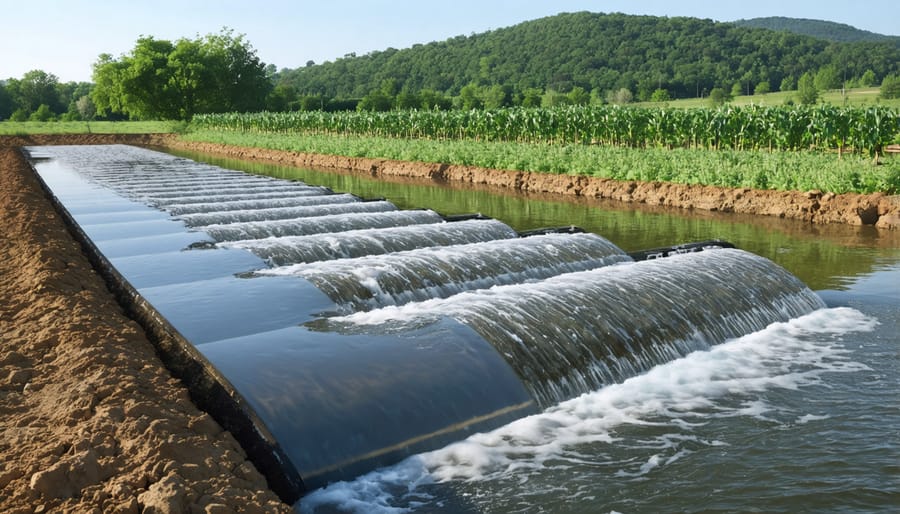
Expert Insights
Dr. Sarah Thompson, a leading agricultural scientist at the University of Alberta, emphasizes the importance of integrated approaches to water pollution management. “What we’re seeing in successful Alberta farms is a combination of buffer zones and precision irrigation techniques,” she notes. “Farmers who implement these methods typically see a 40% reduction in agricultural runoff within the first year.”
Local farmer Mike Henderson, who runs a 2,000-hectare operation near Lethbridge, shares his experience: “We installed vegetative buffer strips along our waterways three years ago. The improvement in water quality has been remarkable, and we’ve noticed increased wildlife activity too.”
Agricultural extension specialist Jennifer Martinez points out that timing is crucial. “Many Alberta farmers are now using soil moisture sensors to optimize irrigation schedules. This not only reduces water waste but also minimizes the movement of nutrients into waterways.”
Research conducted at the Lacombe Research Centre shows promising results from controlled drainage systems. “We’ve documented a 60% reduction in nitrogen losses when combining controlled drainage with cover crops,” explains Dr. Robert Chen, the centre’s lead researcher.
These experts agree that success comes from a community-based approach. “When neighbouring farms work together on water management strategies, we see the best results,” says Thompson. “It’s about creating a watershed-wide solution that benefits everyone.”
As we’ve explored throughout this article, reducing water pollution on our farms isn’t just an environmental responsibility – it’s a smart business decision that benefits our entire agricultural community. By implementing these water conservation strategies, Alberta farmers are leading the way in sustainable agriculture while maintaining productive and profitable operations.
The methods we’ve discussed – from buffer zones and cover crops to precision irrigation and responsible chemical management – are proven solutions that work in our unique Canadian climate. Many of your fellow farmers have already seen remarkable results, with improved soil health, reduced input costs, and better crop yields while protecting our precious water resources.
Remember, every step counts, whether you’re starting with simple runoff management or implementing advanced filtration systems. The support network is strong, with local agricultural extension offices, conservation authorities, and experienced neighbors ready to share their knowledge and experiences.
By working together and gradually adopting these practices, we’re not just preserving water quality for our farms – we’re securing a sustainable future for the next generation of Canadian farmers. The success stories we’ve shared demonstrate that environmental stewardship and agricultural prosperity can go hand in hand. Let’s continue to be leaders in responsible farming practices and show the world how Alberta farmers are making a difference.

